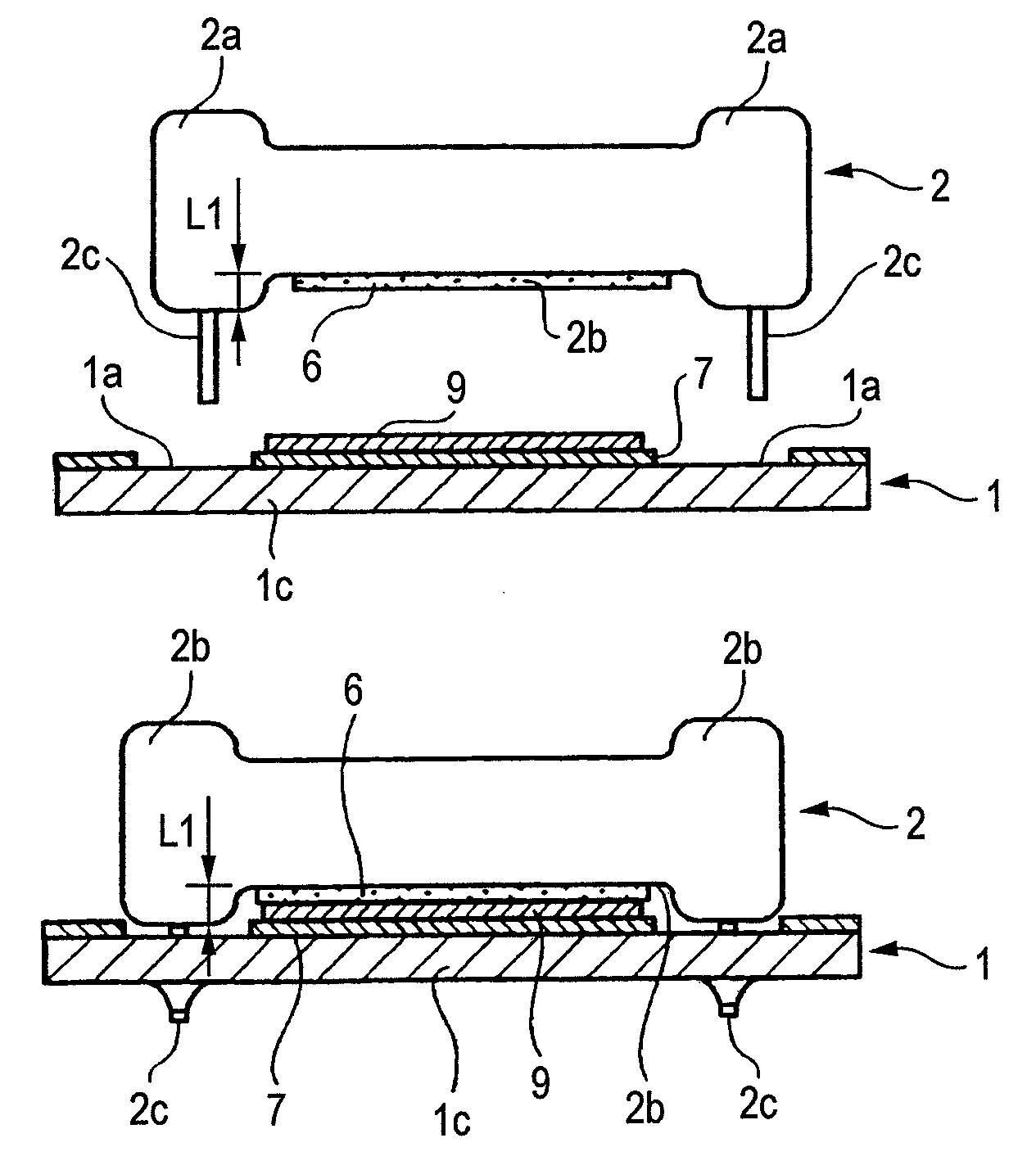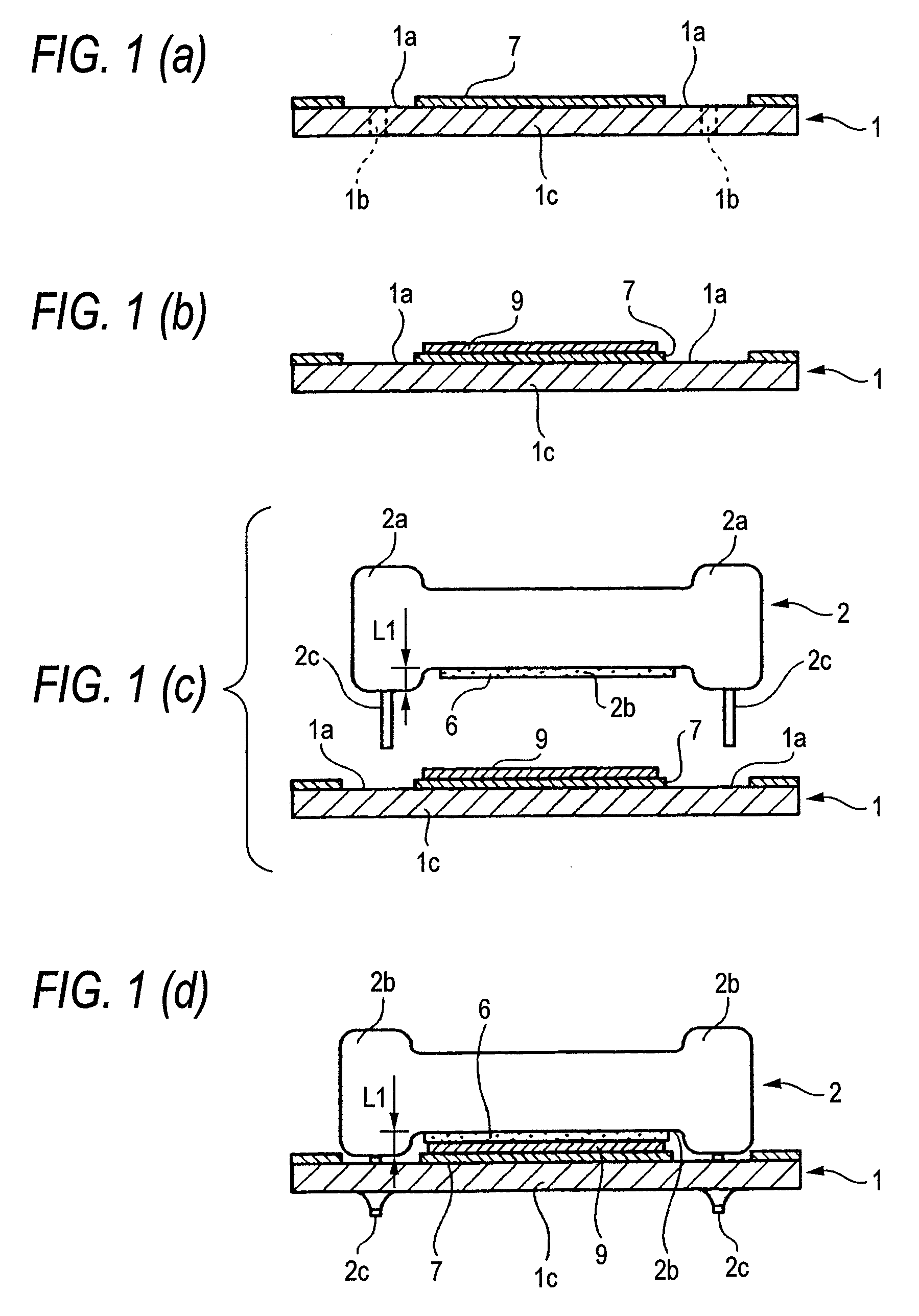Component fixing method
a fixing method and component technology, applied in the direction of resist details, electrical apparatus construction details, variable capacitors, etc., can solve the problems of mechanical fixing methods that lack reliability and compactness, three kinds of fixing methods have respective problems that remain unsolved, and etc., to achieve excellent reliability and compactness, enhance vibration resistance, and overcome the difficulty of controlling the bonding strength
- Summary
- Abstract
- Description
- Claims
- Application Information
AI Technical Summary
Benefits of technology
Problems solved by technology
Method used
Image
Examples
first embodiment
[0033]FIGS. 1A to 1D is a process view showing a first embodiment of a component fixing method of the invention, and FIG. 1A is a cross-sectional view showing a resist forming step, FIG. 1B is a cross-sectional view showing a printing step, and FIGS. 1C and 1D are cross-sectional views showing a component bonding step. FIG. 2 is a perspective view showing a circuit component, FIG. 3 is a plan view of the circuit component of FIG. 2, and FIG. 4 is a front-elevational view of the circuit component of FIG. 2.
[0034]As shown in FIGS. 2 to 4, the circuit component 10 includes a flat plate-like printed circuit board (PCB) 1, and a film capacitor 2 is mounted in a laid-down posture on the printed circuit board 1. Namely, two lead passage holes 1b are formed through the printed circuit board 1. On the other hand, the film capacitor 2 comprises a pair of electrode portions 2a, a concave portion 2b interconnecting these electrode portions 2a, and a pair of lead wires 2c extending respectively ...
second and third embodiments
[0048]FIG. 5 is a process view showing a second embodiment of a component fixing method of the invention, and FIG. 5A is a cross-sectional view showing a condition before a film capacitor is bonded to a printed circuit board, and FIG. 5B is a cross-sectional view showing a condition after the film capacitor is bonded to the printed circuit board. FIG. 6 is a process view showing a third embodiment of a component fixing method of the invention, and FIG. 6A is a cross-sectional view showing a condition before a film capacitor is bonded to a printed circuit board, and FIG. 6B is a cross-sectional view showing a condition after the film capacitor is bonded to the printed circuit board.
[0049]In the above first embodiment, the resist material is coated on the printed circuit board 1 except the electrode-opposing portions 1a thereof, and by doing so, the electrode portions 2a of the film capacitor 2 are spaced from the printed circuit board 1, and therefore these electrode portions 2a are ...
PUM
| Property | Measurement | Unit |
|---|---|---|
| thickness | aaaaa | aaaaa |
| thickness | aaaaa | aaaaa |
| concave-convex height difference L1 | aaaaa | aaaaa |
Abstract
Description
Claims
Application Information
 Login to View More
Login to View More - R&D
- Intellectual Property
- Life Sciences
- Materials
- Tech Scout
- Unparalleled Data Quality
- Higher Quality Content
- 60% Fewer Hallucinations
Browse by: Latest US Patents, China's latest patents, Technical Efficacy Thesaurus, Application Domain, Technology Topic, Popular Technical Reports.
© 2025 PatSnap. All rights reserved.Legal|Privacy policy|Modern Slavery Act Transparency Statement|Sitemap|About US| Contact US: help@patsnap.com



